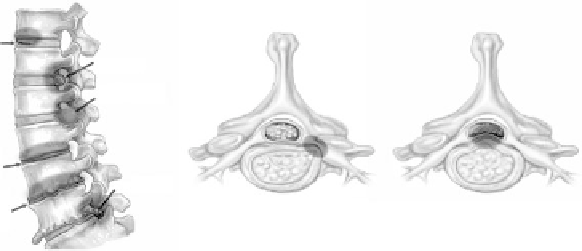Biomedical Engineering Reference
In-Depth Information
16.1 IntroduCtIon
16.1.1 i
nterVerteBral
d
iSc
d
iSeaSe
Alteration in the biomechanical properties of a disc is a typical characteristic of intervertebral disc
degeneration. The exact pathogenesis of the degenerative process is still unknown (An, Thonar, and
Masuda 2003). It has been suggested that disc degeneration might be predetermined genetically,
occurring during the aging process, or may be caused by overloading or underloading (Goel et al.
2006). Loss of nutrition to the disc may be an important factor in its degeneration. It is likely that
almost any abnormal loading condition can lead to adaptive changes that may in turn lead to the
degeneration of the disc (Eck et al. 2002).
As the source of disc degeneration, knowledge of the biomechanical load is needed to under-
stand the degenerative progress. In theory, once degeneration sets in, the intervertebral disc goes
through a cascade of degenerative changes that result in biomechanical alteration of load transfer
through the disc, in turn causing changes in the mechanical properties and composition of the tis-
sue. Structural disorganization of the intervertebral disc along with loss in proteoglycans stemming
from degeneration causes the hydrostatic mechanism to fail (Eck et al. 2002). There are different
ways a degenerated disc can lead to low back pain or neck pain. Depending on whether the degen-
eration occurs in the nucleus pulposus or the annulus, the degenerated disc may be classified into
several modalities (Figure 16.1).
A degenerated annulus could have fissures that consist of microscopic fragmentation of indi-
vidual fibers. Annular tears at the corners of the vertebral body separating the annulus from the end
plates are also seen. Disc bulging may occur due to a decrease in the radial tensile strength of the
annulus. Degeneration of the nucleus occurs following loss of water content leading to collagenation
of the nucleus, which results in an increase of the elastic modulus of the nucleus.
Nucleus degeneration combined with annular degeneration may cause disc herniation into
the spinal canal, causing low back pain due to nerve pinching. Thinning of the disc and loss of
disc height are also commonly seen. This loss of disc height combined with gradual ossifica-
tion of the end plate and protrusion of the disc tissue causes stenosis, which again leads to back
pain.
16.1.2 G
old
S
tandard
for
tHe
t
reatment
of
i
nterVerteBral
d
iSc
d
iSeaSe
: S
pinal
f
uSion
Currently, spinal fusion is regarded as the gold standard for the treatment of intervertebral disc
disease. Spinal fusion was first described for the treatment of Pott disease and spinal deformity.
Cervical spine fusion was used initially as a treatment for degenerative spondylotic conditions.
These early authors suggested that spinal fusion offered the surgeon an opportunity to remove
the pathological process (infection, arthritis, or deformity), to eliminate painful motion, and to
allow decompression of the neural elements with subsequent stabilization of the index segment.
Fissures
Bulging
Herniation
Thinning
Stenosis
Ossification
Radiculopathy
Myelopathy
FIgure 16.1
The modalities of spinal disc degeneration.

Search WWH ::

Custom Search